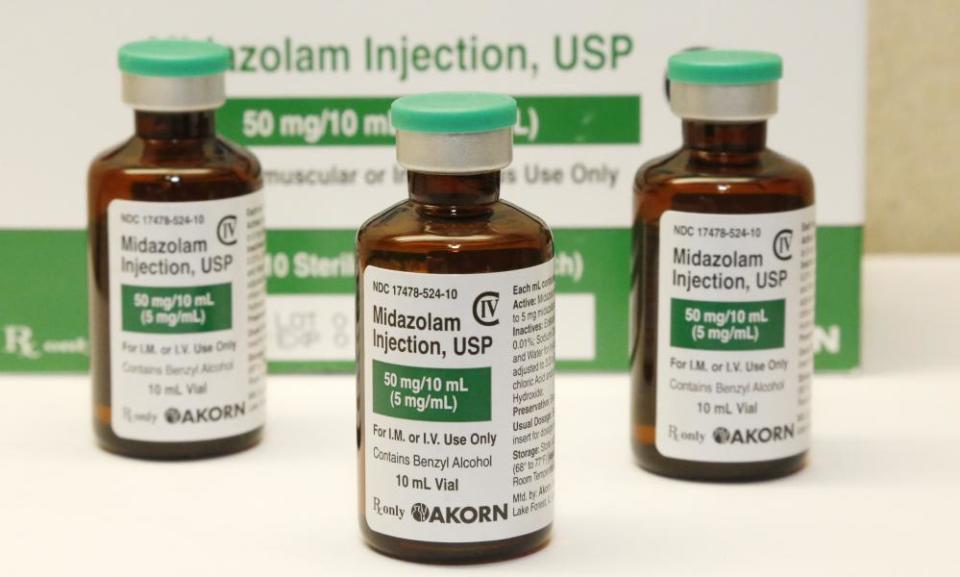Virginia set to execute man using 'potentially torturous' drug cocktail
William Morva is set to be put to death on Thursday using a cocktail of unregulated drugs which have been shown to cause severe distress in the past

Virginia is preparing to kill a 32-year-old man using a controversial lethal injection formula that may have subjected the last prisoner to be executed by the state to an excruciating death equivalent to drowning.
William Morva is set to be put to death on Thursday using a cocktail of three medical drugs. Two of the chemicals have been obtained from compounding pharmacies – private outlets that are not subject to the full regulatory regime followed by regular drug manufacturers.
As a result, the drugs can be of variable quality and strength. New evidence relating to the Virginia execution of Ricky Gray six months ago suggests that the patchy consistency of the lethal drugs may have caused a terrifying outcome.
The deceased prisoner’s family has obtained Gray’s official autopsy report, which was carried out in January and is being revealed by the Guardian for the first time. It contains alarming evidence of potentially extreme distress on the inmate’s part.
The autopsy report contains routine information about the prisoner’s body, such as the “Coolie High” tattoo he had on his right arm and that he was dressed in blue jeans, shirt and boxer shorts. It also discloses details of a highly rare and disturbing nature.
It notes that “blood-tinged fluid is present from the mouth” and that “the upper airways contains foamy liquid”. It also finds that the body’s lungs were “severely congested” and that there were “red cells present in the airways”.
Mark Edgar, an associate professor of pathology at Emory University school of medicine has examined the autopsy report and said that its finding of a frothy liquid in the upper airways was very unusual. It was an indication, he said, of acute pulmonary edema, in which fluid collects in the lungs and overwhelms an individual’s ability to breathe.
The presence of foamy liquid in the upper airways is only found in the most severe cases of the condition, which can come from acute heart failure or actual drowning. Edgar said he could not say for certain why the edema happened in the course of Gray’s execution, but he was sure about the human consequences of something akin to drowning from within.
“This way of dying is intolerable. You can’t control your breathing – it is terrible,” Edgar said. “When it is this severe you can experience panic and terror, and if the individual was in any way aware of what was happening to them it would be unbearable.”
The Richmond Times-Dispatch described Gray’s execution. According to the paper, a minute into the lethal injection procedure, after the drug Midazolam was injected into him, the prisoner lifted up his head, “looked around, moved his toes and legs. He appeared to take a number of deep breaths and he appeared to make snoring or groaning sounds.”
Gray, 39, was executed for the brutal murders in 2006 of a family of four in Richmond, including musician Bryan Harvey, his wife Kathryn and two daughters aged nine and four. A few days later he went on a second killing binge in which he murdered an acquaintance, Ashley Baskerville, his mother, Mary Tucker, and stepfather Percyell Tucker.
Thursday’s execution has the added complication that William Morva has shown signs of serious mental illness almost eight years before he was sentenced to death for killing a hospital security guard, Derrick McFarland, and county sheriff Eric Sutphin in 2006. The prisoner has appealed for clemency to the Democratic governor of Virginia, Terry McAuliffe, who has so far declined to intervene.
McAuliffe is nominally opposed to the death penalty, but he allowed the execution of Gray to proceed. He was also the architect of legislation that imposed some of the most stringent secrecy laws of any death penalty state.
Under those laws, it is not possible to find out the identity of the compounding pharmacies that produced two of the three drugs in the state’s lethal injection cocktail. But Virginia has given lawyers the results of tests carried out on its batches of drugs that provide further alarming evidence of haphazard standards.
The test results show vast discrepancies in the strength of the compounded chemicals. Some of the vials of Midazolam, a drug that has been used in several botched executions including that of Clayton Lockett in Oklahoma, who writhed and groaned on the gurney for 43 minutes, were found to be barely two-thirds the recommended strength – well below official standards.
The potassium chloride, a fearsome drug that is used in executions to stop the heart but can induce the sensation of having liquid fire inside the veins, was found to be as low as 89% strength in some batches.
Maya Foa, director at the international rights charity Reprieve, accused Virginia’s department of corrections of “dealing drugs on the black market, under cover of a secrecy law that shields back-alley compounding labs from regulation”. She said that the drugs in the state’s possession had already “led to one prolonged and potentially torturous execution” and were now set to be injected into Morva within hours.
“Rather than relying on chance to decide whether William Morva dies in agony, Governor McAuliffe should intervene and stop this execution,” she said.
The attorney for condemned prisoner, Dawn Davison, said that instead of focusing on killing Morva the state should give him treatment for severe mental illness. “Nothing can be gained by pushing ahead, except subjecting a vulnerable man to a potentially slow and excruciating death.”

